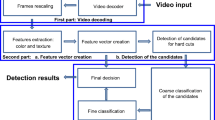Abstract
Video partitioning is the segmentation of a videosequence into visually independent partitions,which represent various identifiable scenes in thevideo. It is an important first step inconsidering other issues in video databasesmanagement, such as indexing and retrieval. Asvideo partitioning is a computationally intensiveprocess, effective management of digital videorequires highly efficient techniques for theprocess. In general, for compressed anduncompressed video, the basic mechanism used toreduce computation is by selective processing of asubpart of the video frames. However, so farthe choice of this proportion has been maderandomly, without any formal basis. An ad hocselection of this subpart cannot always guaranteea reduction in computation while ensuringeffective partitioning.
This paper presents formal methods for determiningthe optimal window size and the minimum thresholdswhich ensure that decisions on scene similarityare made on a reliable, effective and principledbasis. Further, we propose the use ofneighbourhood-based colour ratios, and derive theratio feature for both uncompressed and transformcoded video. The neighbourhood-based ratiofeatures account for both illumination variationand possible motion in the video, while avoidingthe computational burden of explicit motioncompensation procedures. Empirical results showing the performance of the proposed techniques are are also presented.
Similar content being viewed by others
References
D.A. Adjeroh and M.C. LeeMechanisms for automatic extraction of primary features for video indexing,” In, Chin et al. (eds.), Lecture Notes in Computer Science: Image Analysis Applications and Computer Graphics, Springer-Verlag: Berlin-Heildelberg, 1995.
D.A. Adjeroh and M.C. LeeProbabilistic similarity evaluation using fast incremental matching with optimal premature termination,” Submitted.
F. Arman, A. Hsu, and M-Y ChiuImage processing on encoded video sequences,” Multimedia Systems, Vol. 1, pp. 211–219, 1994.
S-F Chang and D. G. MesserschmittManipulation and compositing of MC-DCT compressed video,” IEEE Journal of Selected Areas in Communication, Vol. 13, pp. 1–11, 1994.
R.J. Clarke, Transform Coding of Images, Academic Press, London, 1985.
B.V. Funt and G.D. FinlaysonColor constant color indexing,” IEEE Transactions on Pattern Analysis and Machine Intelligence, Vol. 17, pp. 522–529, 1995.
D. LeGallMPEG: A video compression standard for multimedia applications,” Communications of the ACM, Vol. 34, pp. 46–58, 1991.
L.S. Gross and L. W. Ward, Electronic Moviemaking, Wadsworth Publishing Co.: Belmont, California, 1994.
A. Hampapur, R. Jain and T. E. WeymouthProduction model based digital video segmentation,” Multimedia Tools and Applications: An International Journal, Vol. 1, pp. 9–46, 1995.
M.C. Lee and D. A AdjerohIndexing and retrieval in visual databases via colour ratio histograms,” in Proceedings, 1st International Conference on Visual Information Systems, Melbourne Australia, 1996, pp. 309–316.
M. LiouOverview of the px64 kbits/s video coding standard,” Communications of the ACM, Vol. 34, pp. 59–63, 1991.
J. Meng, Y. Juan and S-F ChangScene change detection in a MPEG compressed video sequence,” in Proceedings, IS&T/SPIE Conference on Digital Video Compression and Algorithms, pp. 14–25, 1995.
A. Nagasaka, and Y. TanakaAutomatic video indexing and full-video search for object appearances,” In, E. Knuth, and L.M. Wegner (eds.), Visual Database Systems II, Elsevier Science Publishers, pp. 113–127, 1992.
H. Nicolas and L. LabitMotion and illumination variation estimation using a hierarchy of models: application to image sequence coding,” Journal of Visual Communication and Image Representation, Vol. 6, pp. 303–316, 1995.
K. Otsuji, and Y. TonomuraProjection-detecting filter for video cut detection,” Multimedia Systems, Vol. 1, pp. 205–210, 1994.
W.B. Pennebaker and J.L Mitchell, JPEG Still Image Data Compression Standard, Van Nostrad Reinhold: New York, 1993.
R. Polana and R. NelsonDetecting activities,” Journal of Visual Communication and Image Representation, Vol. 5, pp. 172–180, 1994.
K.R. Rao and P. Yip, Discrete Cosine Transform: Algorithms, Advantages, Applications, Academic Press Inc.: Boston, 1990.
B.C. Smith and L. A RoweAlgorithms for manipulating compressed images,” IEEE Computer Graphics and Applications, Vol. 13, pp. 34–42, 1993.
D. Swanberg, C-F Shu, and R. JainKnowledge guided parsing of video databases,” in Proceecdings, IS&T/SPIE Symposium on Electronic Imaging Science and Technology (Storage and Retrieval for Image and Video Databases II), San Jose, California, pp. 13–24, 1993.
Y. TonomuraVideo handling based on structured information for hypermedia systems,” in Proceedings, International Conference on Multimedia Information Systems, Singapore, 1991 pp. 333–344.
M.J. Vrhel, H.J. Trussell, and J. BoschDesign and realization of optimal color filters for multi-illuminant color correction,” Journal of Electronic Imaging, Vol. 4, pp. 6–14, 1995.
G. K. WallaceThe JPEG still picture compression standard,” Communications of the ACM, Vol. 34, pp. 31–44, 1991.
W. Xiong, J. C-M Lee, M-C IpNet comparison: a fast and effective method for classifying image sequences,” in Proceedings, IS&T/SPIE Conference on Storage and Retrieval for Image and Video Databases III, 1995, pp. 318–28.
H-J Zhang, A. Kankanhilli, A. and S.W SmoliarAutomatic partitioning of full-motion video,” Multimedia Systems, Vol. 1, pp. 10–28, 1993.
H-J Zhang, L.C. Yong, S. W. SmoliarVideo partitioning and browsing using compressed data,” Multimedia Tools and Applications: An International Journal, Vol. 1, pp. 91–111, 1995.
Author information
Authors and Affiliations
Rights and permissions
About this article
Cite this article
Adjeroh, D.A., Lee, M. & Orji, C.U. Techniques for Fast Partitioning of Compressed and Uncompressed Video. Multimedia Tools and Applications 4, 225–243 (1997). https://doi.org/10.1023/A:1009674517240
Issue Date:
DOI: https://doi.org/10.1023/A:1009674517240




